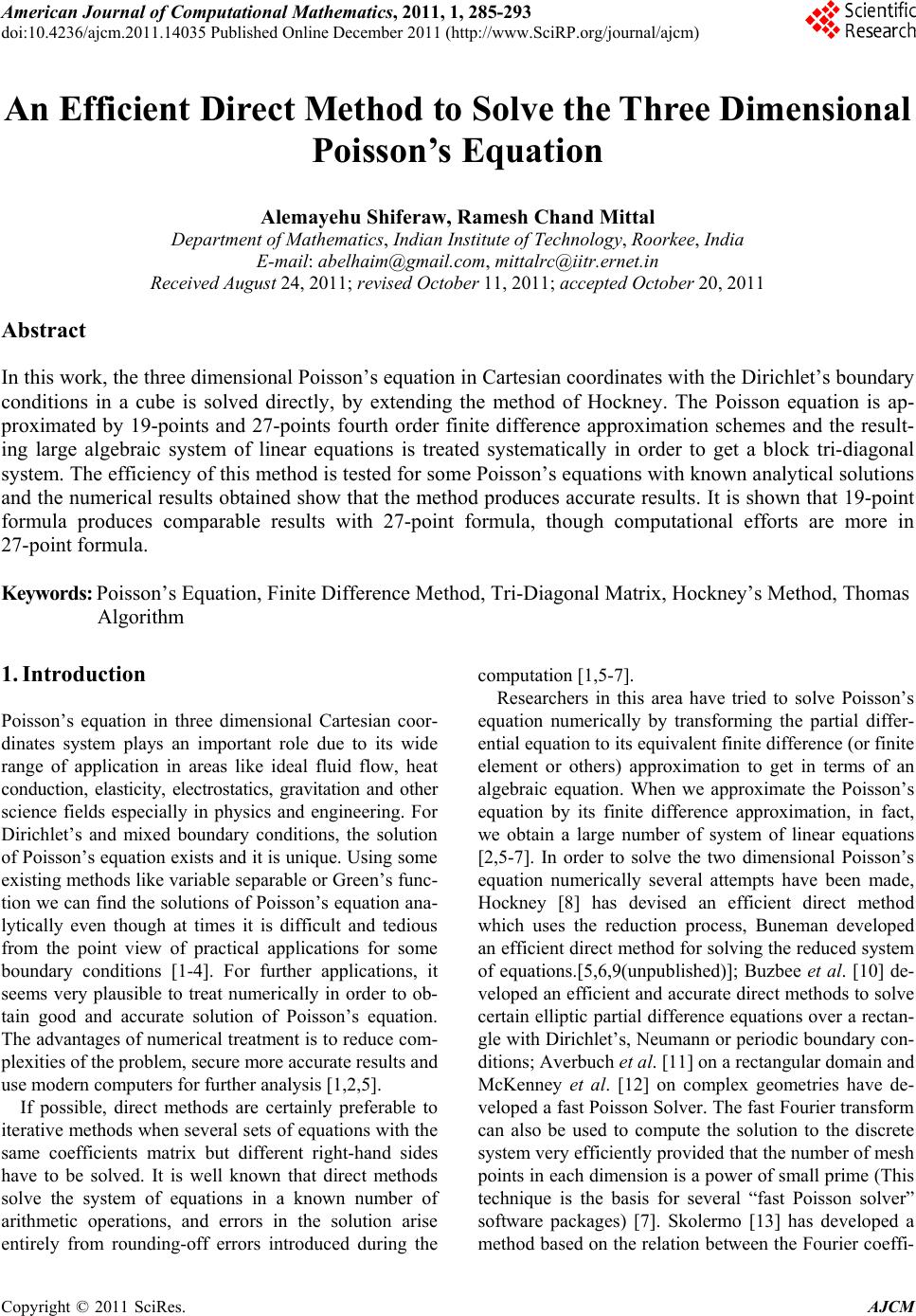 American Journal of Computational Mathematics, 2011, 1, 285-293 doi:10.4236/ajcm.2011.14035 Published Online December 2011 (http://www.SciRP.org/journal/ajcm) Copyright © 2011 SciRes. AJCM An Efficient Direct Method to Solve the Three Dimensional Poisson’s Equation Alemayehu Shiferaw, Ramesh Chand Mittal Department of Mat hematics, Indian Institute of Technology, Roorkee, India E-mail: abelhaim@gmail.com, mittalrc@iitr.ernet.in Received August 24, 2011; revised October 11, 2011; accepted October 20, 2011 Abstract In this work, the three dimensional Poisson’s equation in Cartesian coordinates with the Dirichlet’s boundary conditions in a cube is solved directly, by extending the method of Hockney. The Poisson equation is ap- proximated by 19-points and 27-points fourth order finite difference approximation schemes and the result- ing large algebraic system of linear equations is treated systematically in order to get a block tri-diagonal system. The efficiency of this method is tested for some Poisson’s equations with known analytical solutions and the numerical results obtained show that the method produces accurate results. It is shown that 19-point formula produces comparable results with 27-point formula, though computational efforts are more in 27-point formula. Keywords: Poisson’s Equation, Finite Difference Method, Tri-Diagonal Matrix, Hockney’s Method, Thomas Algorithm 1. Introduction Poisson’s equation in three dimensional Cartesian coor- dinates system plays an important role due to its wide range of application in areas like ideal fluid flow, heat conduction, elasticity, electrostatics, gravitation and other science fields especially in physics and engineering. For Dirichlet’s and mixed boundary conditions, the solution of Poisson’s equation exists and it is unique. Using some existing methods like variable separable or Green’s func- tion we can find the solutions of Poisson’s equation ana- lytically even though at times it is difficult and tedious from the point view of practical applications for some boundary conditions [1-4]. For further applications, it seems very plausible to treat numerically in order to ob- tain good and accurate solution of Poisson’s equation. The advantages of numerical treatment is to reduce com- plexities of the problem, secure more accurate results and use modern computers for further analysis [1,2,5]. If possible, direct methods are certainly preferable to iterative methods when several sets of equations with the same coefficients matrix but different right-hand sides have to be solved. It is well known that direct methods solve the system of equations in a known number of arithmetic operations, and errors in the solution arise entirely from rounding-off errors introduced during the computation [1,5-7]. Researchers in this area have tried to solve Poisson’s equation numerically by transforming the partial differ- ential equation to its equivalent finite difference (or finite element or others) approximation to get in terms of an algebraic equation. When we approximate the Poisson’s equation by its finite difference approximation, in fact, we obtain a large number of system of linear equations [2,5-7]. In order to solve the two dimensional Poisson’s equation numerically several attempts have been made, Hockney [8] has devised an efficient direct method which uses the reduction process, Buneman developed an efficient direct method for solving the reduced system of equations.[5,6,9(unpublished)]; Buzbee et al. [10] de- veloped an efficient and accurate direct methods to solve certain elliptic partial difference equations over a rectan- gle with Dirichlet’s, Neumann or periodic boundary con- ditions; Averbuch et al. [11] on a rectangular domain and McKenney et al. [12] on complex geometries have de- veloped a fast Poisson Solver. The fast Fourier transform can also be used to compute the solution to the discrete system very efficiently provided that the number of mesh points in each dimension is a power of small prime (This technique is the basis for several “fast Poisson solver” software packages) [7]. Skolermo [13] has developed a method based on the relation between the Fourier coeffi- 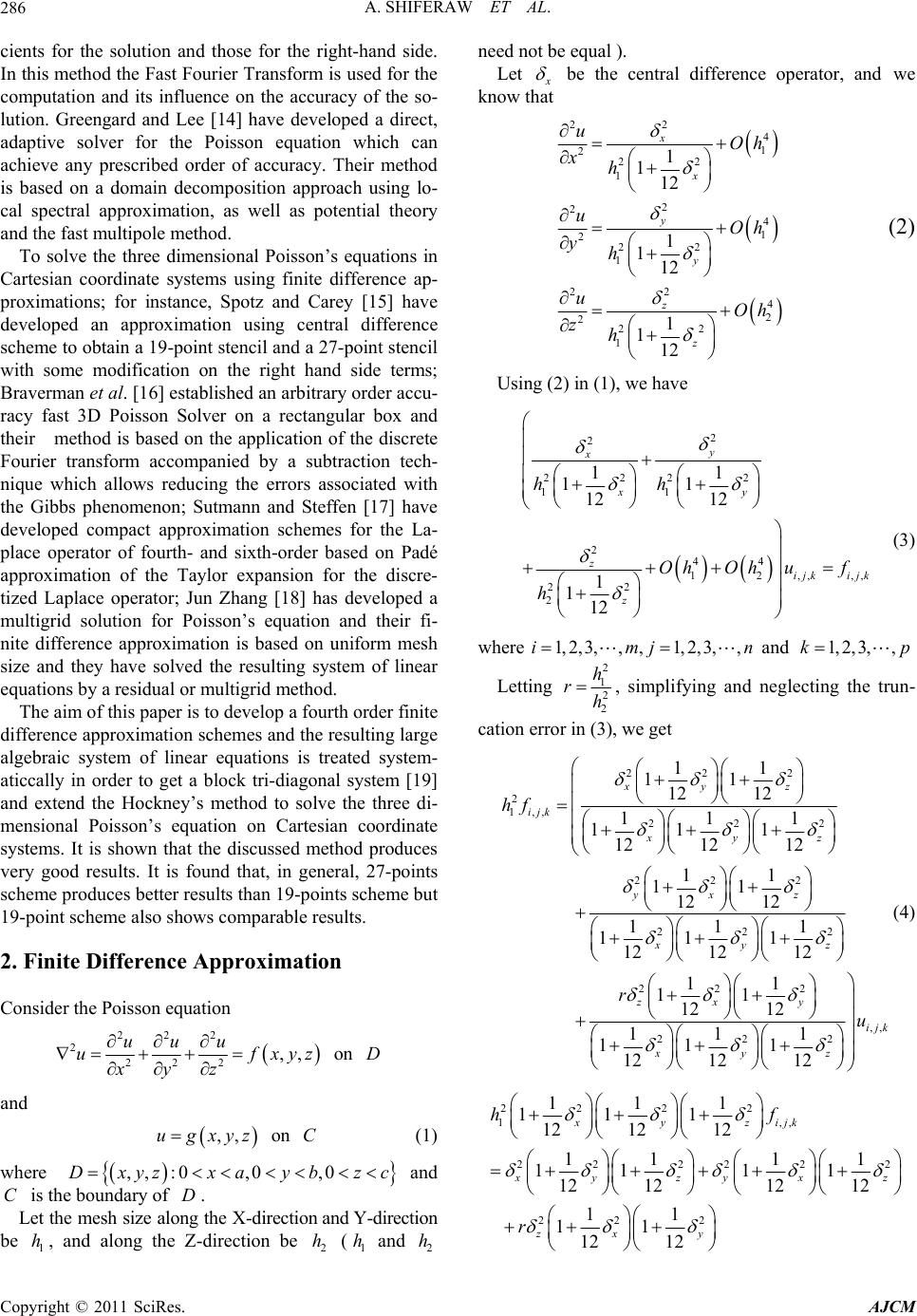 A. SHIFERAW ET AL. 286 cients for the solution and those for the right-hand side. In this method the Fast Fourier Transform is used for the computation and its influence on the accuracy of the so- lution. Greengard and Lee [14] have developed a direct, adaptive solver for the Poisson equation which can achieve any prescribed order of accuracy. Their method is based on a domain decomposition approach using lo- cal spectral approximation, as well as potential theory and the fast multipole method. To solve the three dimensional Poisson’s equations in Cartesian coordinate systems using finite difference ap- proximations; for instance, Spotz and Carey [15] have developed an approximation using central difference scheme to obtain a 19-point stencil and a 27-point stencil with some modification on the right hand side terms; Braverman et al. [16] established an arbitrary order accu- racy fast 3D Poisson Solver on a rectangular box and their method is based on the application of the discrete Fourier transform accompanied by a subtraction tech- nique which allows reducing the errors associated with the Gibbs phenomenon; Sutmann and Steffen [17] have developed compact approximation schemes for the La- place operator of fourth- and sixth-order based on Padé approximation of the Taylor expansion for the discre- tized Laplace operator; Jun Zhang [18] has developed a multigrid solution for Poisson’s equation and their fi- nite difference approximation is based on uniform mesh size and they have solved the resulting system of linear equations by a residual or multigrid method. The aim of this paper is to develop a fourth order finite difference approximation schemes and the resulting large algebraic system of linear equations is treated system- aticcally in order to get a block tri-diagonal system [19] and extend the Hockney’s method to solve the three di- mensional Poisson’s equation on Cartesian coordinate systems. It is shown that the discussed method produces very good results. It is found that, in general, 27-points scheme produces better results than 19-points scheme but 19-point scheme also shows comparable results. 2. Finite Difference Approximation Consider the Poisson equation 222 2 222 ,, uuu uf xyz xyzD on and ,,ugxyz on C (1) where and is the boundary of . ,,:0 ,0 ,0Dxyzxaybzc D C Let the mesh size along the X-direction and Y-direction be , and along the Z-direction be ( and need not be equal ). 1 h2 h1 h2 h Let be the central difference operator, and we know that 2 2 4 1 2 22 1 2 2 4 1 222 1 2 2 4 2 222 1 1 112 1 112 1 112 x x y y z z uOh xh uOh yh uOh zh (2) Using (2) in (1), we have 2 2 2222 11 2 44 12 ,,,, 22 2 11 11 12 12 1 112 y x xy zijk ijk z hh OhOh uf h (3) where 1,2,3, ,,1,2,3, ,imjn and 1, 2, 3,,kp Letting 2 1 2 2 h rh , simplifying and neglecting the trun- cation error in (3), we get 22 2 2 1,, 222 22 2 222 22 2 11 11 12 12 111 111 12 12 12 11 11 12 12 111 111 12 12 12 11 11 12 12 xy z ijk xyz yx z xyz zx y hf r ,, 222 111 111 12 12 12 ijk xyz u (4) 22 2 2 1, 22 222 222 111 111 12 12 12 11 11 11 11 12 1212 12 11 11 12 12 xyzijk xy zyx zx y hf r , 2 z Copyright © 2011 SciRes. AJCM 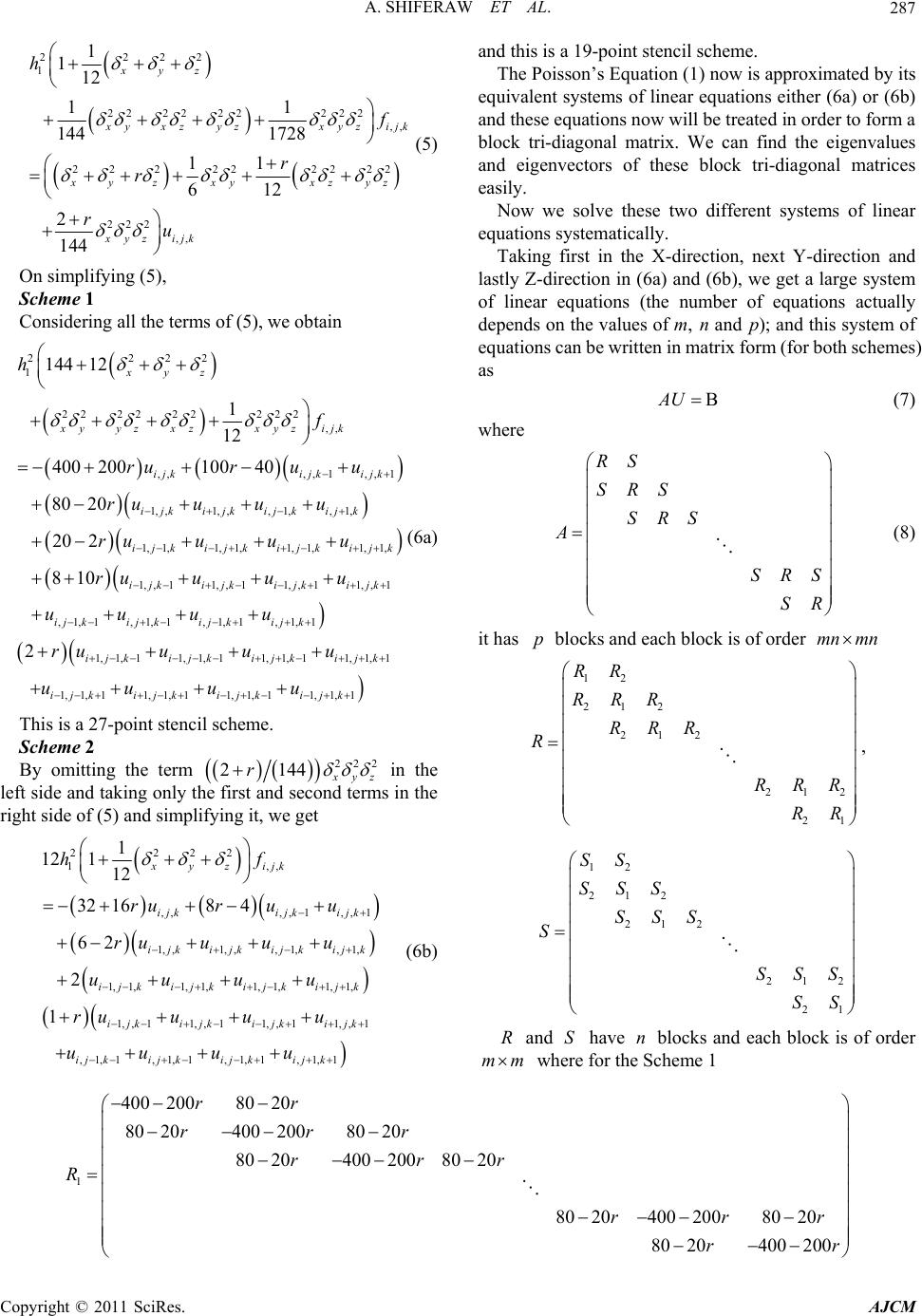 A. SHIFERAW ET AL. Copyright © 2011 SciRes. AJCM 287 2 222 1 22 22 22222 ,, 22 2222222 222 ,, 1 112 11 144 1728 11 612 2 144 xyz yxzyz xyzijk xy zxyxzyz xyz ijk h r r ru (5) and this is a 19-point stencil scheme. The Poisson’s Equation (1) now is approximated by its equivalent systems of linear equations either (6a) or (6b) and these equations now will be treated in order to form a block tri-diagonal matrix. We can find the eigenvalues and eigenvectors of these block tri-diagonal matrices easily. Now we solve these two different systems of linear equations systematically. On simplifying (5), Scheme 1 Considering all the terms of (5), we obtain 2 222 1 22 22 22222 ,, ,,,, 1,, 1 1, ,1, ,,1,,1, 1, 1,1, 1,1, 1,1, 144 12 1 12 400 20010040 8020 202 xyz xyyzxzxyzijk ijkijk ijk ijk ijk ijk ijk ijkijkijkij h f ruru u ru uu u ruuuu 1, 1, ,11, ,11, ,11, ,1 ,1,1,1,1 ,1,1 ,1,1 1, 1, 11, 1, 11, 1, 11, 1, 1 1, 1, 11, 1,11, 1, 1 810 2 k i jki jki jki jk ij kijkijkijk ijk ijk ijk ijk ijk ijk ijk i ruuuu uuuu ru u uu uuuu 1, 1, 1jk (6a) Taking first in the X-direction, next Y-direction and lastly Z-direction in (6a) and (6b), we get a large system of linear equations (the number of equations actually depends on the values of m, n and p); and this system of equations can be written in matrix form (for both schemes) as AU (7) where RS SRS SRS A SRS SR (8) it has blocks and each block is of order pmn mn 12 212 212 212 21 RR RRR RRR R RRR RR , This is a 27-point stencil scheme. Scheme 2 By omitting the term 222 2 144 yz r in the left side and taking only the first and second terms in the right side of (5) and simplifying it, we get 2 222 1,, ,,,, 1,, 1 1, ,1, ,,1,,1, 1, 1,1, 1,1, 1,1, 1, 1, ,11, ,11, ,11, 1 121 12 32 1684 62 2 1 xyzijk ijkijk ijk ijkijkijkijk ijkijkijkijk ijk ijk ijk ij hf rur uu ru u uu uuuu ruuuu ,1 ,1,1 ,1,1 ,1,1 ,1,1 k ijkijk ijkijk uuuu (6b) 12 212 212 212 21 SS SSS SSS S SSS SS R mm and have n blocks and each block is of order S where for the Scheme 1 1 400 20080 20 80 20400 20080 20 80 20400 20080 20 80 20400 20080 20 80 20400 200 rr rrr rrr R rr rr r 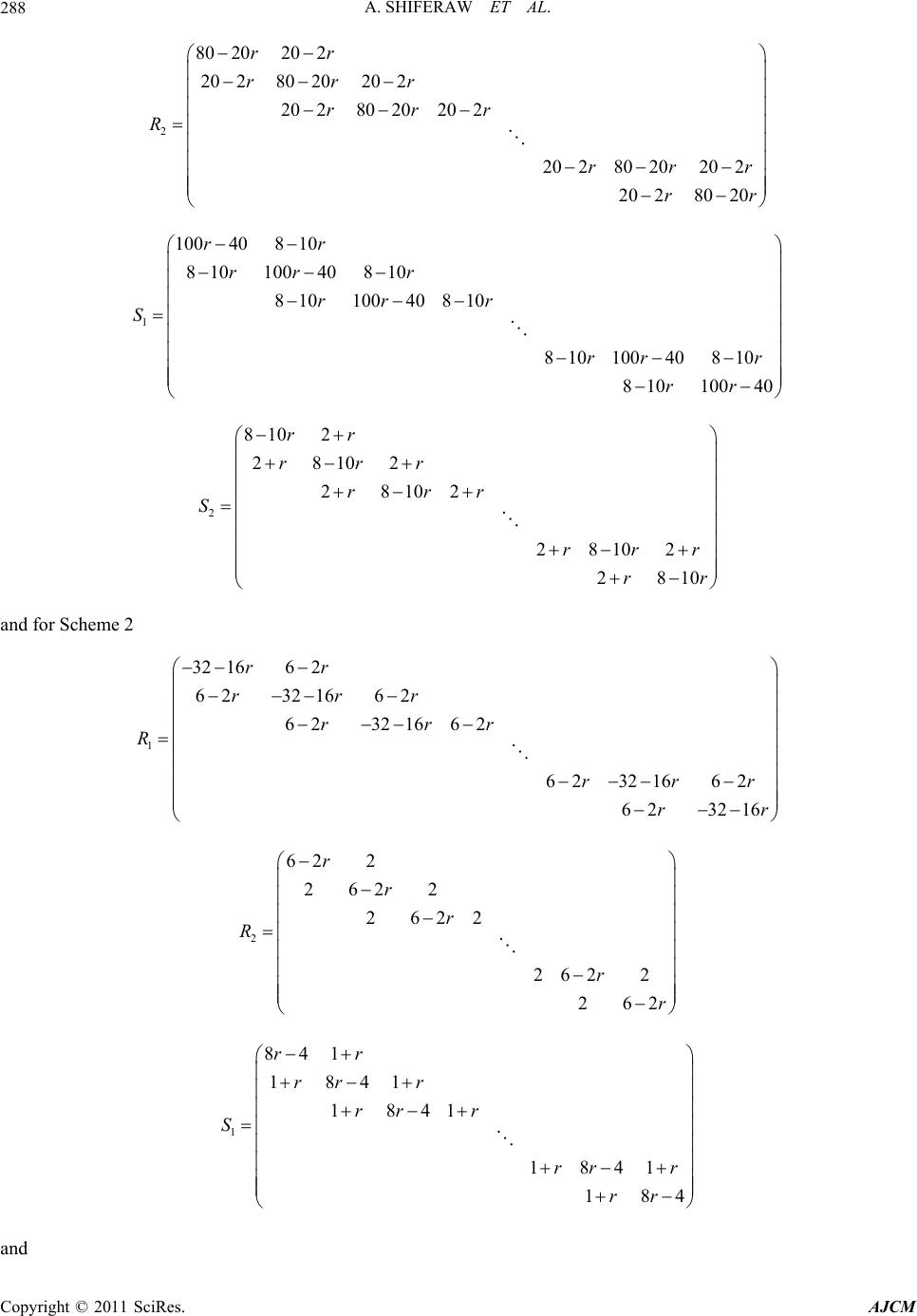 A. SHIFERAW ET AL. 288 r r 2 80 2020 2 2028020 202 2028020202 202 8020202 20 280 20 rr rrr rrr R rr rr 1 10040810 8 10100408 10 8 10100408 10 810 10040810 810100 40 rr rr r rrr S rr r rr 2 810 2 28102 28102 28102 2810 rr rrr rrr S rrr rr and for Scheme 2 1 32 1662 623216 62 62321662 6 232166 2 62 3216 rr rrr rrr R rr rr 2 62 2 262 2 2622 2622 262 r r r R r r 1 841 1841 1841 1841 184 rr rr r rr r S rr r rr and Copyright © 2011 SciRes. AJCM 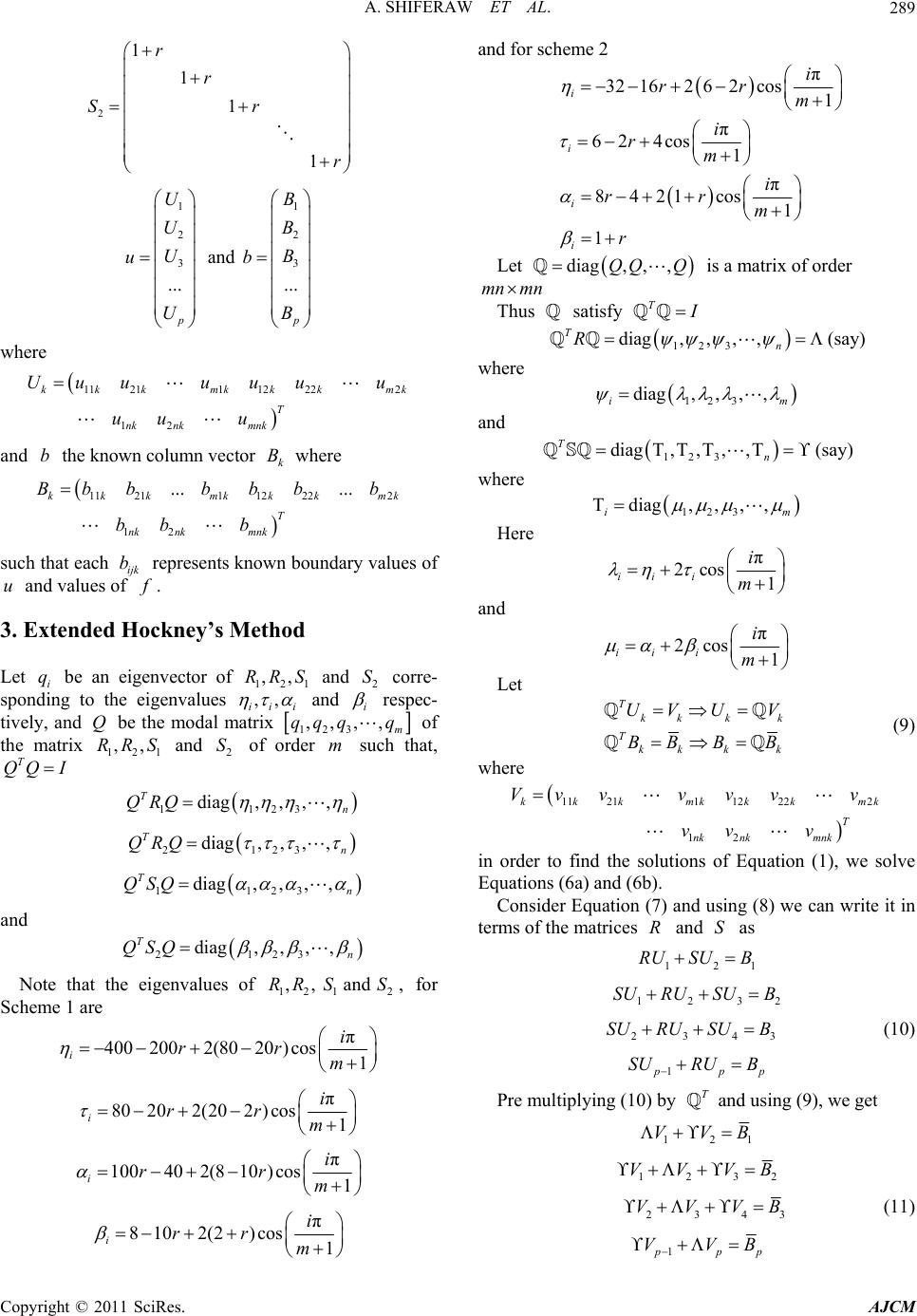 A. SHIFERAW ET AL.289 2 1 1 1 1 r r Sr r and for scheme 2 1 2 3 and ... p U U U u U 1 2 3 ... B B B b B where 11211 12222 12 kkkmkkkm T nk nkmnk Uuuu uuu uu u k k and the known column vector where bk B 1121112222 12 ... ... kkkmkkkm T nk nkmnk Bbbb bbb bb b such that each ijk represents known boundary values of and values of b u . 3. Extended Hockney’s Method Let i be an eigenvector of and 2 corre- sponding to the eigenvalues q121 ,,RRS ,, ii i S and i respec- tively, and be the modal matrix Q 12 ,, , m q m3 of the matrix and of order such that, ,qqq 121 ,,RRS2 S T QQ I 1123 diag, , ,, Tn QRQ 2123 diag,, ,, Tn QRQ 1123 diag,,, , Tn QSQ and 2123 diag,,, , Tn QSQ Note that the eigenvalues of and , for Scheme 1 are 12 1 ,,RR S2 S π 400 2002(80 20)cos1 ii rr m π 80202(202) cos1 ii rr m π 100402(810) cos1 ii rr m π 810 2(2)cos1 ii rr m π 32162 62cos1 ii rr m π 62 4cos1 ii rm π 8421 cos1 ii rr m 1 ir Let diag, ,,QQ Q mn is a matrix order f o mn Thus satisfy TI ,,, 123 diag ,n R T (say) where 12 3 diag ,,,, im and 123 diag,,, , Tn (say) where 123 diag,, , , im Here π 2cos 1 ii ii m and π 2cos 1 ii ii m Let Tkk k Tkk k UV UV BB BB k k (9) where 11211 12222 12 kkk mkkkm T nk nkmnk Vvvv vv vv v k v in order to find the solutions of Equation (1), we solve Equations (6a) and (6b). Consider Equation (7) and using (8) we can write in it terms of the matrices R and S as 121 RU SUB 123 SU RUSBU 2 234 SURU SUB3 (10) 1 pp SURU B T Pre multiplying (10) byand usi ng (9), we get 12 VVB 1 1232 VV VB 234 VVVB 3 (11) 1 pp VV B Copyright © 2011 SciRes. AJCM 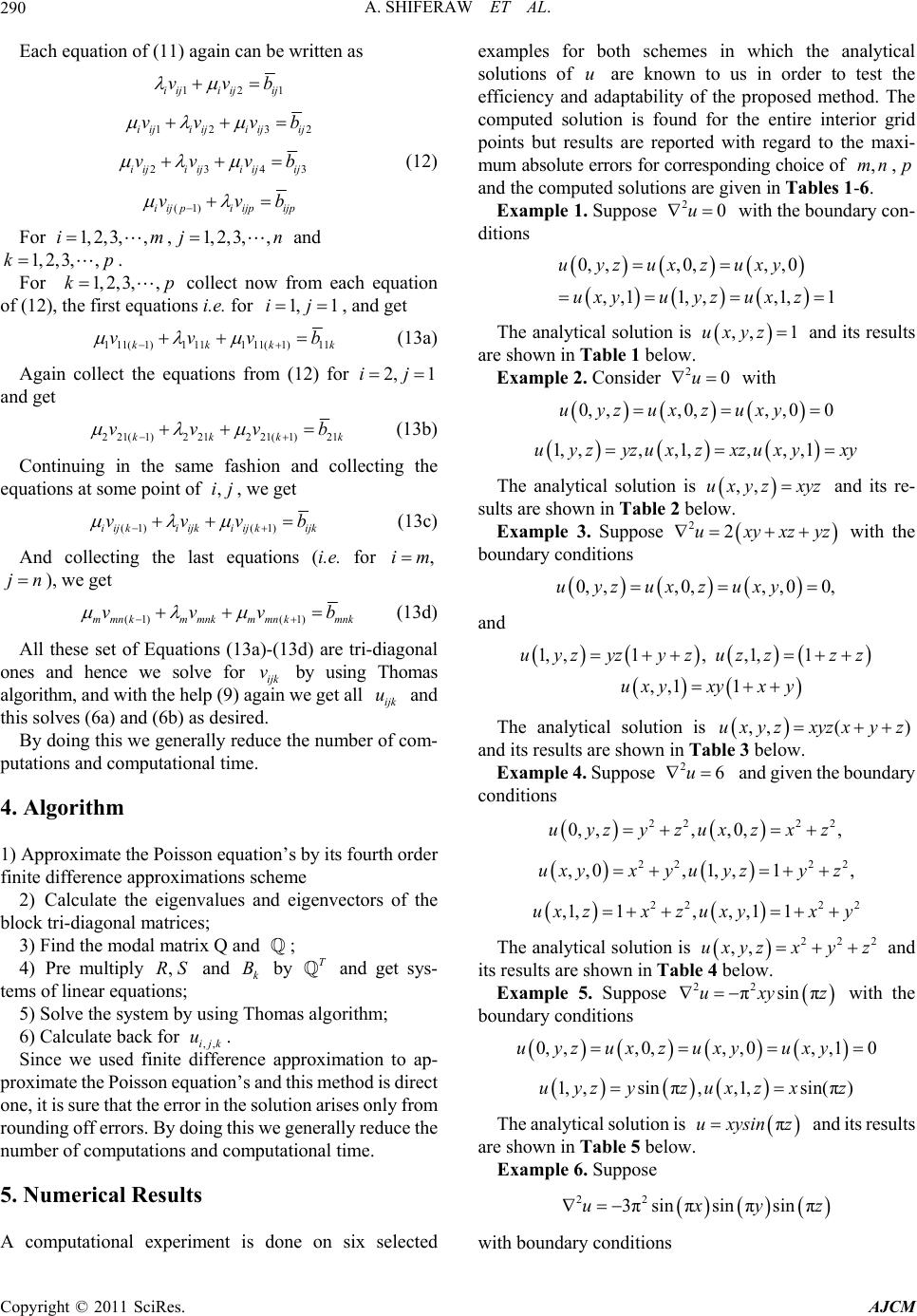 A. SHIFERAW ET AL. 290 Each equation of (11) again can be written as 12iij iij ij vvb 1 12 32iij iijiijij vv vb 23 4iijiijiijij vvvb 3 (12) (1)iij piijpijp vv b For nan For collect now from each equation of s i.e. for , and get 1, 2,3,,im, 2,3,,kp. 1,2, 3,,j d 1, 1,2, 3,,kp the first equation (12),1, 1ij 1 11(1)1kk vvvb (13a) (12) fo 111 11(1)11kk Again collect the equations fromr 2,1ij and get 2 21(1)2 212 21(1)21kkkk Continuing in the same fashion and collecting t equations vvvb he at some point of, we get (13b) ,ij (1)(1)i ijki ijki ijkijk And collecting the lasquations (i.e. for ,im vvvb t e (13c) jn), we get (1)(1)mmnkmmnk mmnkmnk (13a)-(13d) are tri-diag ce we so vvv All these set of Equations onal ones and henlve for by using algorithm, and with the help (9) agwe get a th n’s by its fourth order pproximations scheme e eigenvalues and eigenvectors of the algorithm; for ce apoxim irect on rfrom ro es in which the analytical solutions of are known to us in order to test the b (13d) ijk v ain Thomas ll ijk u and is solves (6a) and (6b) as desired. By doing this we generally reduce the number of com- putations and computational time. 4. Algorithm 1) Approximate the Poisson equatio finite difference a 2) Calculate th block tri-diagonal matrices; 3) Find the modal matrix Q and ; 4) Pre multiply ,RS and k B by T and get sys- tems of linear equations; 5) Solve the system by using Thomas 6) Calculate back ,,ijk u. Since we used finite differenpration to ap- proximate the Poisson equation’s and this method is d in solution arises only e, it is sure that the erro the unding off errors. By doing this we generally reduce the number of computations and computational time. 5. Numerical Results A computational experiment is done on six selected examples for both schem u efficiency and adaptability of the proposed method. The computed solution is found for the entire interior grid points but results are reported with regard to the maxi- mum absolute errors for corresponding choice of ,mn,p and the computed solutions are given in Tables 1-6. Example 1. Suppose 20u with the boundary con- ditions ,, 0,,, 0yzuxzuxy 0,u ,, 11,,,1, 1uxyuyzux z The analytical solution is and its results are shown in Table 1 below. Example 2. Consider ,, 1uxyz 20u with ,, 0zuxy 0,,, 0,0uyzux ,1, ,1zxy xy1, ,,,,uyzyzuxzux The analytical solution is and its re- sults are shown in Table 2 Example 3. Suppose with the bo ,,uxyzxyz below. 22uxyxzyz undary conditions 0, z ,, 00,uxy0, ,,uyzux and 1, ,1,,1,1 ,,11 uyz yzyzuzzzz uxyxyx y The analytical solution is and its results are shown in Ta Example 4. Suppose ,, ()uxyzxyzxy z ble 3 below. 26u and given the boundary conditions 2 0,,, ,, 22 2 , 0 uyzyzxz zux 22 22 ,,01,,1,,yxy uyzyz ux 22 2 ,1,1,, ,11uxzxz uxyx2 y 22 The analytical solution is 2 and its results are shown in Table 4 Example 5. Suppose z with the bo ,,uxyz x y below. z 22 si πnπuxy undary conditions 0,,, 0,,, 0uyzuxzuxy , ,10uxy in π,,1, sin(π)zuxzx z 1, ,suyzy The analytical solution is and its results are shown in Table 5 belo Example 6. Suppose πuxysinz w. 22 sin πsin3πux πsinzyπ with boundary conditions Copyright © 2011 SciRes. AJCM 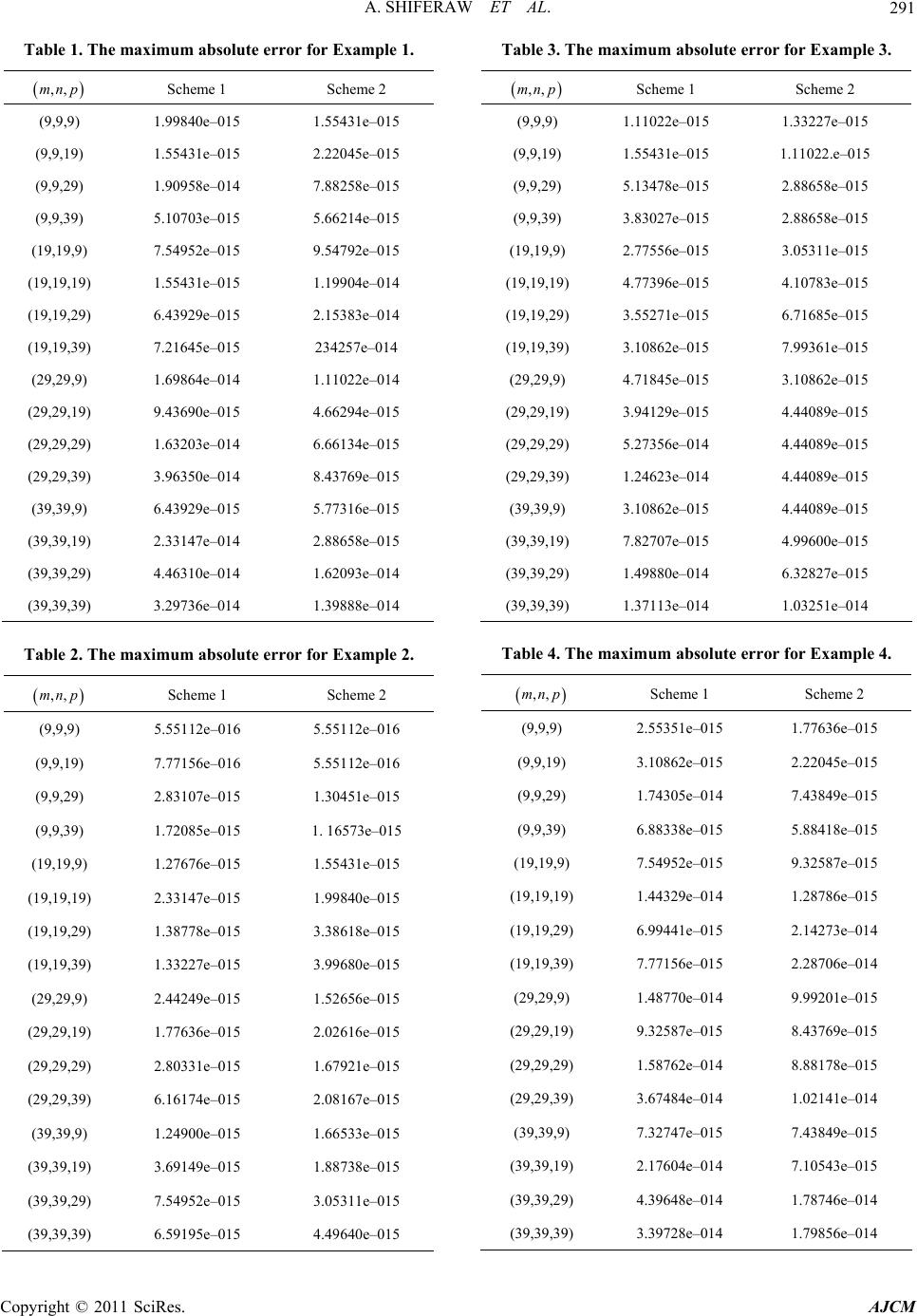 A. SHIFERAW ET AL.291 Table 1. The maximum absolute error for Example 1. e 1 Scheme 2 ,,mnp Schem (9,9,9) 1.99840e–015 1.55431e–015 (9,9,19)5 2.5 ( 1.55431e–0122045e–01 (9,9,29) 1.90958e–014 7.88258e–015 (9,9,39) 5.10703e–015 5.66214e–015 (19,19,9) 7.54952e–015 9.54792e–015 19,19,19) 1.55431e–015 1.19904e–014 (19,19,29) 6.43929e–015 2.15383e–014 (19,19,39) 7.21645e–015 234257e–014 (29,29,9) 1.69864e–014 1.11022e–014 (29,29,19) 9.43690e–015 4.66294e–015 (29,29,29) 1.63203e–014 6.66134e–015 (29,29,39) 3.96350e–014 8.43769e–015 (39,39,9) 6.43929e–015 5.77316e–015 (39,39,19) 2.33147e–014 2.88658e–015 (39,39,29) 4.46310e–014 1.62093e–014 (39,39,39) 3.29736e–014 1.39888e–014 Table 2. The maximum absolute error for Example 2. Scheme 1 Scheme 2 ,,mnp (9,9,9) 5.55112e–016 5.55112e–016 (9,9,19) 5. ( 7.77156e–01655112e–016 (9,9,29) 2.83107e–015 1.30451e–015 (9,9,39) 1.72085e–015 1. 16573e–015 (19,19,9) 1.27676e–015 1.55431e–015 19,19,19) 2.33147e–015 1.99840e–015 (19,19,29) 1.38778e–015 3.38618e–015 (19,19,39) 1.33227e–015 3.99680e–015 (29,29,9) 2.44249e–015 1.52656e–015 (29,29,19) 1.77636e–015 2.02616e–015 (29,29,29) 2.80331e–015 1.67921e–015 (29,29,39) 6.16174e–015 2.08167e–015 (39,39,9) 1.24900e–015 1.66533e–015 (39,39,19) 3.69149e–015 1.88738e–015 (39,39,29) 7.54952e–015 3.05311e–015 (39,39,39) 6.59195e–015 4.49640e–015 Table 3. The maxrror f. imum absolute eor Example 3 ,,mnp Scheme 1 Scheme 2 (9,9,9) 1.11022e–015 1.33227e–015 (9,9,19)5 1.5 ( 1.55431e–0111022.e–01 (9,9,29) 5.13478e–015 2.88658e–015 (9,9,39) 3.83027e–015 2.88658e–015 (19,19,9) 2.77556e–015 3.05311e–015 19,19,19) 4.77396e–015 4.10783e–015 (19,19,29) 3.55271e–015 6.71685e–015 (19,19,39) 3.10862e–015 7.99361e–015 (29,29,9) 4.71845e–015 3.10862e–015 (29,29,19) 3.94129e–015 4.44089e–015 (29,29,29) 5.27356e–014 4.44089e–015 (29,29,39) 1.24623e–014 4.44089e–015 (39,39,9) 3.10862e–015 4.44089e–015 (39,39,19) 7.82707e–015 4.99600e–015 (39,39,29) 1.49880e–014 6.32827e–015 (39,39,39) 1.37113e–014 1.03251e–014 e mate error 4. Table 4. Thximum absolu for Example ,,mnp Scheme 1 Scheme 2 (9,9,9) 2.55351e–015 1.77636e–015 (9,9,19) 2. ( 3.10862e–01522045e–015 (9,9,29) 1.74305e–014 7.43849e–015 (9,9,39) 6.88338e–015 5.88418e–015 (19,19,9) 7.54952e–015 9.32587e–015 19,19,19) 1.44329e–014 1.28786e–015 (19,19,29) 6.99441e–015 2.14273e–014 (19,19,39) 7.77156e–015 2.28706e–014 (29,29,9) 1.48770e–014 9.99201e–015 (29,29,19) 9.32587e–015 8.43769e–015 (29,29,29) 1.58762e–014 8.88178e–015 (29,29,39) 3.67484e–014 1.02141e–014 (39,39,9) 7.32747e–015 7.43849e–015 (39,39,19) 2.17604e–014 7.10543e–015 (39,39,29) 4.39648e–014 1.78746e–014 (39,39,39) 3.39728e–014 1.79856e–014 Copyright © 2011 SciRes. AJCM 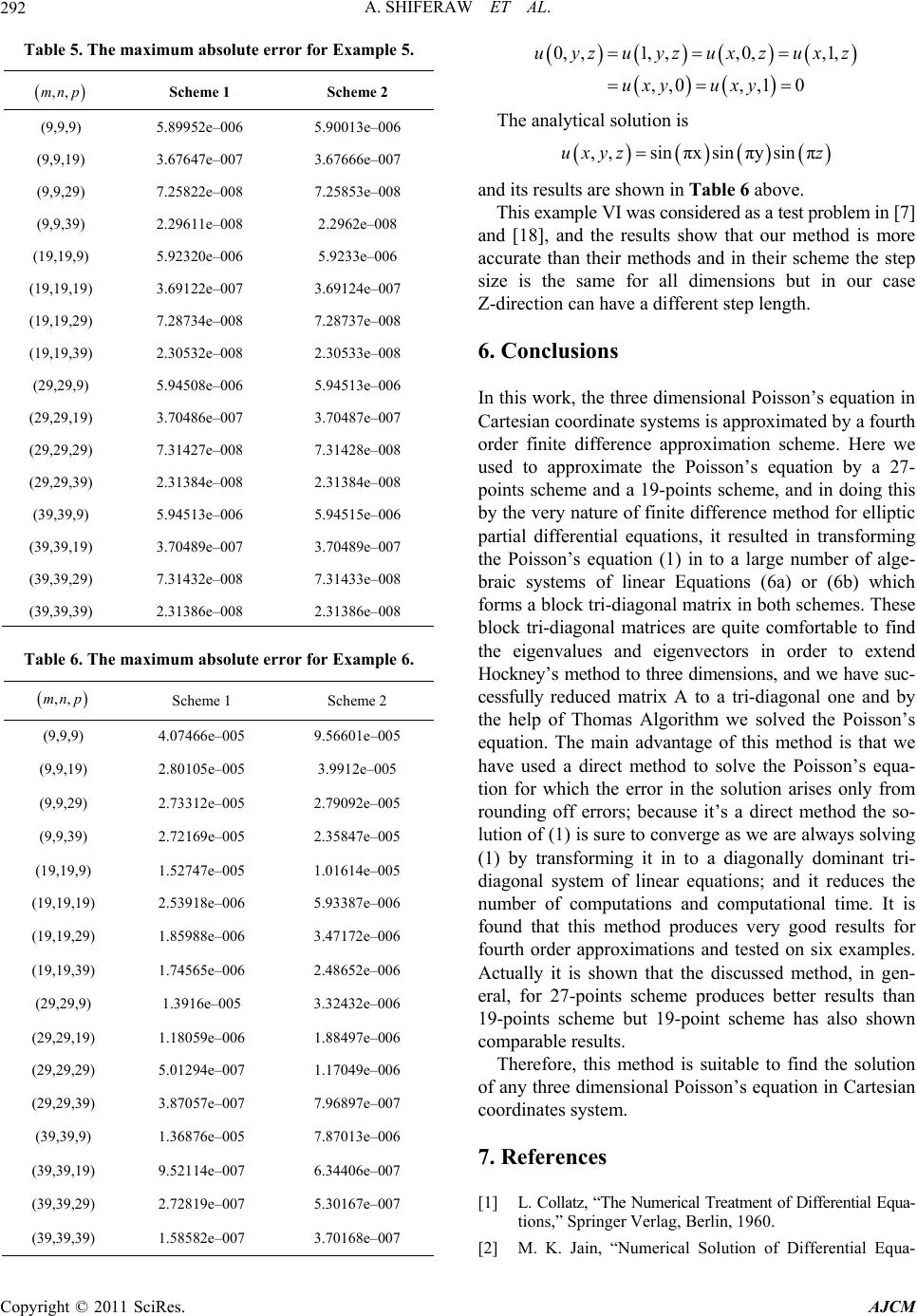 A. SHIFERAW ET AL. 292 Te maxi error f. able 5. Thmum absoluteor Example 5 ,,mnp Scheme 1 Scheme 2 (9,9,9) 5.89952e–006 5.90013e–006 (9,9,19) 3. ( 3.67647e–00767666e–007 (9,9,29) 7.25822e–008 7.25853e–008 (9,9,39) 2.29611e–008 2.2962e–008 (19,19,9) 5.92320e–006 5.9233e–006 19,19,19) 3.69122e–007 3.69124e–007 (19,19,29) 7.28734e–008 7.28737e–008 (19,19,39) 2.30532e–008 2.30533e–008 (29,29,9) 5.94508e–006 5.94513e–006 (29,29,19) 3.70486e–007 3.70487e–007 (29,29,29) 7.31427e–008 7.31428e–008 (29,29,39) 2.31384e–008 2.31384e–008 (39,39,9) 5.94513e–006 5.94515e–006 (39,39,19) 3.70489e–007 3.70489e–007 (39,39,29) 7.31432e–008 7.31433e–008 (39,39,39) 2.31386e–008 2.31386e–008 Tabe maximurror fo Scheme 1 Scheme 2 le 6. Thm absolute er Example 6. ,,mnp (9,9,9) 4.07466e–005 9.56601e–005 (9,9,19) 3. ( 2.80105e–0059912e–005 (9,9,29) 2.73312e–005 2.79092e–005 (9,9,39) 2.72169e–005 2.35847e–005 (19,19,9) 1.52747e–005 1.01614e–005 19,19,19) 2.53918e–006 5.93387e–006 (19,19,29) 1.85988e–006 3.47172e–006 (19,19,39) 1.74565e–006 2.48652e–006 (29,29,9) 1.3916e–005 3.32432e–006 (29,29,19) 1.18059e–006 1.88497e–006 (29,29,29) 5.01294e–007 1.17049e–006 (29,29,39) 3.87057e–007 7.96897e–007 (39,39,9) 1.36876e–005 7.87013e–006 (39,39,19) 9.52114e–007 6.34406e–007 (39,39,29) 2.72819e–007 5.30167e–007 (39,39,39) 1.58582e–007 3.70168e–007 1,,yzux , ,0, ,,1 zuz u xy ,1,uxz ,, 0xy u 0,uy 0 The analytical solution is ,, sinπxsinπysinπuxyzz an able 6 above. This example VI was considered as a test problem in [7] and [18], and the results show that our meth is more eme the step siz In this work, the three dimensional Poisson’s equation in systems is approximated by a fourth order finite difference approximation scheme. Here we [1] L. Collatz, “The Numerical Treatment of Differential Equa- r Verlag, Berlin, 1960. [2] M. K. Jain, “Numerical Solution of Differential Equa- d its results are shown in T od accurate than their methods and in their sch e is the same for all dimensions but in our case Z-direction can have a different step length. 6. Conclusions Cartesian coordinate used to approximate the Poisson’s equation by a 27- points scheme and a 19-points scheme, and in doing this by the very nature of finite difference method for elliptic partial differential equations, it resulted in transforming the Poisson’s equation (1) in to a large number of alge- braic systems of linear Equations (6a) or (6b) which forms a block tri-diagonal matrix in both schemes. These block tri-diagonal matrices are quite comfortable to find the eigenvalues and eigenvectors in order to extend Hockney’s method to three dimensions, and we have suc- cessfully reduced matrix A to a tri-diagonal one and by the help of Thomas Algorithm we solved the Poisson’s equation. The main advantage of this method is that we have used a direct method to solve the Poisson’s equa- tion for which the error in the solution arises only from rounding off errors; because it’s a direct method the so- lution of (1) is sure to converge as we are always solving (1) by transforming it in to a diagonally dominant tri- diagonal system of linear equations; and it reduces the number of computations and computational time. It is found that this method produces very good results for fourth order approximations and tested on six examples. Actually it is shown that the discussed method, in gen- eral, for 27-points scheme produces better results than 19-points scheme but 19-point scheme has also shown comparable results. Therefore, this method is suitable to find the solution of any three dimensional Poisson’s equation in Cartesian coordinates system. 7. References tions,” Springe Copyright © 2011 SciRes. AJCM  A. SHIFERAW ET AL. Copyright © 2011 SciRes. AJCM 293 Partial Differential ew York, 1985. duction to Numerical Ana- Equa- 0.321259 tions,” New Age International Ltd., New Delhi, 1984. [3] R. Haberman, “Elementary Applied Equations with Fourier Series and Boundary Value Prob- lems,” Prentice-Hall Inc., Saddle River, 1987. [4] T. Myint-U and L. Debnath, “Linear Partial Differential Equations for Scientists and Engineers,” Birkhauser, Bos- ton, 2007 [5] G. D. Smith, “Numerical Solutions of Partial Differential Equations: Finite Difference Methods,” Oxford Univer- sity Press, N [6] G. H. Golub and C. F. van Loan, “Matrix Computations,” Johns Hopkins University Press, Baltimore, 1989. [7] J. Stoer and R. Bulirsch, “Intro lysis,” Springer-Verlag, New York, 2002. [8] R. W. Hockney, “A Fast Direct Solution of Poisson tion Using Fourier Analysis,” Journal of ACM, Vol. 12, No. 1, 1965, pp. 95-113. doi:10.1145/32125 [9] W. W. Lin, “Lecture Notes of Matrix Computations,” Na- tional Tsing Hua University, Hsinchu, 2008. [10] B. L. Buzbee, G. H. Golub and C. W. Nielson, “On Di- rect Methods for Solving Poisson’s Equations,” SIAM Journal on Numerical Analysis, Vol. 7, No. 4, 1970, pp. 627-656. doi:10.1137/0707049 [11] A. Averbuch, M. Israeli and L. Vozovoi, “A Fast Pois- son’s Solver of Arbitrary Order Accuracy in Rectangular regions,” SIAM Journal on Scientific Computing, Vol. 19, No. 3, 1998, pp. 933-952. doi:10.1137/S1064827595288589 [12] A. McKenney, L. Greengard and A. Mayo, “A Fast Pois- son Solver for Complex Geometries,” Journal of Compu- tation Physics, Vol. 118, No. 2, 1996, pp. 348-355. doi:10.1006/jcph.1995.1104 [13] G. Skolermo, “A Fourier Method for Numerical Solution Direct Adaptive Poisson of Poisson’s Equation,” Mathe matics of Computation, Vol. 29, No. 131, 1975, pp. 697-711. [14] L. Greengard and J. Y. Lee, “A Solver of Arbitrary Order Accuracy,” Journal of Compu- tation Physics, Vol. 125, No. 2, 1996, pp. 415-424. doi:10.1006/jcph.1996.0103 [15] W. F. Spotz and G. F. Carey, “A High-Order Compact -2426(199603)12:2<235::AID-N Formulation for the 3D Poisson Equation,” Numerical Methods for Partial Differential Equations, Vol. 12, No. 2, 1996, pp. 235-243. doi:10.1002/(SICI)1098 UM6>3.0.CO;2-R [16] E. Braverman, M. Israeli, A. Averbuch and L. Vozovoi, “A Fast 3D Poisson Solver of Arbitrary Order Accuracy,” Journal of Computation Physics, Vol. 144, No. 1, 1998, pp. 109-136. doi:10.1006/jcph.1998.6001 [17] G. Sutmann and B. Steffen, “High Order Compact Solvers for the Three-Dimensional Poisson Equation,” Journal of Computation and Applied Mathematics, Vol. 187, No. 2, 2006, pp. 142-170. doi:10.1016/j.cam.2005.03.041 [18] J. Zhang, “Fast and High Accuracy Multigrid Solution of the Three Dimensional Poisson Equation,” Journal of Computation Physics, Vol. 143, No. 2, 1998, pp. 449- 461. doi:10.1006/jcph.1998.5982 [19] M. A. Malcolm and J. Palmer, “A Fast Method for Solv- ing a Class of Tri-Diagonal Linear Systems,” Communi- cations of the ACM, Vol. 17, No. 1, 1974, pp. 14-17. doi:10.1145/360767.360777
|